|
DODGE CORONET History
Introduction: The
Dodge Coronet was Dodge's entry into the midsize segment. It first appeared
in the mid 1950s, disappeared, and then reappeared in the mid 1960s. With
R/T trim, and packing some serious power, the Coronet was a true muscle
car sleeper.
1953 Dodge Coronet
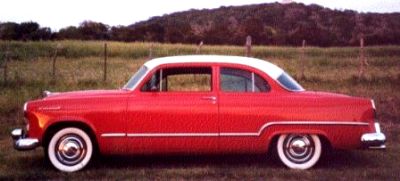 Comments:
The Dodge Coronet underwent a tremendous change for 1953, including all
new styling, an updated, downsized chassis (in two sizes), and most importantly,
the Red Ram V8, which initially came standard in the top-line Coronet.
The 241.4 cid V8 was of a hemispherical head design, just like the Chrysler
FirePower, only in a smaller size. With a two-barrel carb and regular gas
burning 7.1:1 compression, the Red Ram produced 140 bhp - which was pretty
good for 1953. The styling was rounder and smoother, and updated the old-looking
1949-52 body and finally integrated the rear fenders into the rest of the
body. Two and four door sedans came on a 119 inch wheelbase, down 4.5 inches
from 1952, and the two-door hardtop, convertible and two-door station wagons
came on a 114 inch wheelbase, an inch shorter than the earlier low-priced
Wayfarer models. It didn't take stock car racers very long to recognize
that more power in a shorter, lighter body was good for racing, and Dodge
scored six NASCAR Grand National wins in 1953. The Diplomat two-door hardtop
was priced at ,361 and 17,334 were sold. The Diplomat convertible cost
,494 and 4,100 were sold. Both came with the Red Ram V8 standard and
launched Dodge performance. Comments:
The Dodge Coronet underwent a tremendous change for 1953, including all
new styling, an updated, downsized chassis (in two sizes), and most importantly,
the Red Ram V8, which initially came standard in the top-line Coronet.
The 241.4 cid V8 was of a hemispherical head design, just like the Chrysler
FirePower, only in a smaller size. With a two-barrel carb and regular gas
burning 7.1:1 compression, the Red Ram produced 140 bhp - which was pretty
good for 1953. The styling was rounder and smoother, and updated the old-looking
1949-52 body and finally integrated the rear fenders into the rest of the
body. Two and four door sedans came on a 119 inch wheelbase, down 4.5 inches
from 1952, and the two-door hardtop, convertible and two-door station wagons
came on a 114 inch wheelbase, an inch shorter than the earlier low-priced
Wayfarer models. It didn't take stock car racers very long to recognize
that more power in a shorter, lighter body was good for racing, and Dodge
scored six NASCAR Grand National wins in 1953. The Diplomat two-door hardtop
was priced at ,361 and 17,334 were sold. The Diplomat convertible cost
,494 and 4,100 were sold. Both came with the Red Ram V8 standard and
launched Dodge performance.
Production: Diplomat
2D Hardtop Coupe: 17,334. Diplomat 2D Convertible: 4,100.
Engines: 241.4 V8
140 bhp.
Performance: 241/140bhp:
0-60 in 16.1 sec.
1954 Dodge Coronet
Comments: The Dodge
Coronet received a minor face lift for 1954, and horsepower on automatic
transmission cars was increased to 150. A Dodge Coronet convertible was
the pace car for the 1954 Indy 500 and 701 replicas were built.
Engines: 241.4 V8
140 bhp (manual transmission). 241.4 V8 150 bhp (automatic transmission)
1956 Dodge Coronet
Comments: The Dodge
Coronet was used as the basis for Dodge's version of MOPAR performance.
Unlike the other Chrysler super cars (Plymouth Fury, DeSoto Adventurer,
and Chrysler 300B), the new Dodge Coronet D-500 was visually indistinguishable
from normal Dodges upon which it was based. The only external clues were
discreet, crossed checkered flags and "500" lettering on its lower rear
deck. The D-500 option (named for the NASCAR requirement that 500 identical
models must be produced in order to be raced) was also available on any
Dodge model, including station wagons and two door sedans. The D-500 option
included a 315 cid V8 with hemispherical heads (unlike other Dodge V8s
which used polyspherical heads), a unique camshaft, valve lifters, pushrods,
carburetor, ignition, and pistons. With a compression ratio of 9.25:1,
four barrel Carter WCFB carburetor, and dual point distribution, peak horsepower
was 260 bhp while torque was a solid 330 lb-ft. The D-500 came with a standard
three-speed heavy duty manual transmission. The optional Powerflite push
button automatic transmission had a kick down feature. A 3.73:1 rear axle
ratio was standard, but several others were optional. The D-500 also received
an upgraded suspension with very stiff front coil springs with heavy duty
Oriflow shock absorbers, with the same valving specified for Dodge police
cars, were mounted in the springs. Similar units were used in the rear.
A sturdy 0.8125 inch high rate stabilizer bar was also installed. Overall
height of the D-500 was 1.5 inches lower than its standard Dodge counterpart.
The D-500 came standard with 15x5.5 inch wheels with 7.60x15 inch tubeless
tires. Optional were heavy duty 15x6.5 inch wheels. DeSoto/Chrysler 12
inch diameter drum brakes were used in the D-500, providing a total effective
bracking area of 251 square inches, compared to 173.5 square inches on
regular Dodges. An even hotter version of the D-500, the D-550-1 was intended
primarily for NASCAR competition. The D-550-1 had an even stiffer suspension
than the D-500. Under the hood, the engine received larger valves (about
18% larger), a full-race cam shaft, and a double log intake manifold that
used two four barrel Carter WCFB carbs. This all added up to 285 bhp.
Engines: D-500: 315
Hemi V8 260 bhp @ 4800 rpm, 330 lb-ft @ 3000 rpm. D-550-1: 315 Hemi V8
285 bhp.
Performance: 315/260:
0-60 in 8.8 seconds.
1957 Dodge Coronet
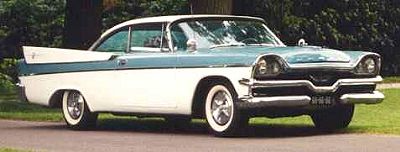 Comments:
1957 saw the debut of the new D-501, which replaced the D-500 from the
year before as the top Coronet. The D-501 received Chrysler's proven 354
cid Hemi V8, which were actually left over engines from the 1956 Chrysler
300B production. Camshafts from the 1957 Chrysler 392 cid engines were
installed in the 354 V8s for added kick. Topped with a pair of Carter four
barrel carbs and sporting a 10.0:1 compression ratio, the new engine put
out 340 bhp. Other changes included the addition of the Torsion-Aire Ride
(torsion bar) front suspension and a heavy duty suspension with heavy duty
shock absorbers and a heavy duty leaf sprung rear. A 3.73:1 rear axle was
standard with the three-speed manual transmission, but automatic cars received
a 3.18:1 rear axle. There were 13 optional rear axles available, ranging
from 2.92:1 through 6.17:1. The D-501 received 7.60x15 tires wrapped around
15x8 inch wheels. Brakes were impressive 12 inch diameter drums. Only 101
D-501s were produced. Comments:
1957 saw the debut of the new D-501, which replaced the D-500 from the
year before as the top Coronet. The D-501 received Chrysler's proven 354
cid Hemi V8, which were actually left over engines from the 1956 Chrysler
300B production. Camshafts from the 1957 Chrysler 392 cid engines were
installed in the 354 V8s for added kick. Topped with a pair of Carter four
barrel carbs and sporting a 10.0:1 compression ratio, the new engine put
out 340 bhp. Other changes included the addition of the Torsion-Aire Ride
(torsion bar) front suspension and a heavy duty suspension with heavy duty
shock absorbers and a heavy duty leaf sprung rear. A 3.73:1 rear axle was
standard with the three-speed manual transmission, but automatic cars received
a 3.18:1 rear axle. There were 13 optional rear axles available, ranging
from 2.92:1 through 6.17:1. The D-501 received 7.60x15 tires wrapped around
15x8 inch wheels. Brakes were impressive 12 inch diameter drums. Only 101
D-501s were produced.
Production: D-501:
101.
Engines: D-501: 354
Hemi V8 340 bhp @ 5200 rpm.
1965 Dodge Coronet
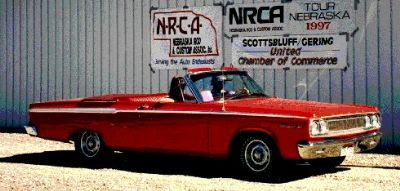
Comments: The Dodge
Coronet was reborn for 1965 as Dodge's midsize entry. From the start, the
Coronet meant performance and was available with the full race 426 Hemi,
seriously under rated at 425 bhp (most estimates are 550-600 bhp). But
the Race Hemi was a little too uncivilized for most amateurs and few were
sold.
Engines: 426 Race
Hemi V8 425 bhp.
1966 Dodge Coronet

Comments: 1966 saw
the introduction of the Street Hemi, and the Dodge Coronet was the perfect
showcase for it. The Street Hemi was made more manageable by installing
a hydraulic lifter cam and a 10.25:1 compression ratio. It was rated at
the same 425 bhp as the Race version and cost less than 0 more. Only
340 Coronet 500 Hardtops received the Hemi engine (204 of them four speeds),
along with 21 convertibles (12 with four speeds). Another 379 Coronets
also had Hemis.
Engines: 426 V8 Hemi
425bhp@5000rpm, 490lb-ft@4000rpm.
Performance: 426/425:
0-60 in 6.1 seconds, 1/4 mile in 14.5 seconds.
1967 Dodge Coronet
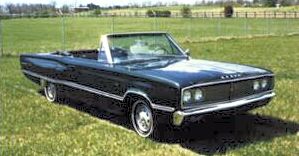 Comments:
The Dodge Coronet was face-lifted front and rear for 1967. Simulated air
vents and racing stripes were added to the body sides. Mag-style wheelcovers
were new, while bucket seats and a console remained standard. New for 1967
was the Coronet R/T (Road/Track), which was the performance model that
was equally at home on the road and on the track. The Coronet R/T 2 door
hardtop was priced at ,199 and the R/T convertible at ,438. Standard
was the new wedge-head Magnum 440 cid V8. With a four barrel Carter AFB
carb, it was rated at 375 bhp. A TorqueFlite automatic was standard and
a four-speed manual gearbox was optional. Also standard on the R/T was
7.75x14 red stripe rubber, heavy-duty shocks plus torsion bars and leafs,
stronger brakes and a front sway bar. The Coronet received a Charger-like
grille, but lacked the retractable headlights of the Charger. A non-functional
hood scoop, R/T badging, and front bucket seats added to the performance
image. If that wasn't enough, buyers could order the mighty 426 Hemi for
just 7 more. Only 238 Hemi Coronets were produced, of which 102 had
the TorqueFlite transmission. Comments:
The Dodge Coronet was face-lifted front and rear for 1967. Simulated air
vents and racing stripes were added to the body sides. Mag-style wheelcovers
were new, while bucket seats and a console remained standard. New for 1967
was the Coronet R/T (Road/Track), which was the performance model that
was equally at home on the road and on the track. The Coronet R/T 2 door
hardtop was priced at ,199 and the R/T convertible at ,438. Standard
was the new wedge-head Magnum 440 cid V8. With a four barrel Carter AFB
carb, it was rated at 375 bhp. A TorqueFlite automatic was standard and
a four-speed manual gearbox was optional. Also standard on the R/T was
7.75x14 red stripe rubber, heavy-duty shocks plus torsion bars and leafs,
stronger brakes and a front sway bar. The Coronet received a Charger-like
grille, but lacked the retractable headlights of the Charger. A non-functional
hood scoop, R/T badging, and front bucket seats added to the performance
image. If that wasn't enough, buyers could order the mighty 426 Hemi for
just 7 more. Only 238 Hemi Coronets were produced, of which 102 had
the TorqueFlite transmission.
Almost all Hemi Coronets
were R/T models, but a few Hemi powered Coronet 440 two door hardtops snuck
out of the factory. These were built to meet National Hot Rod Association
Super Stock B rules and the WO23 cars, as they were known, were the latest
in a line of special lightweight models for drag racing. A Street Hemi
Coronet 440 tipped the scales at 3,686 lbs, resulting in a power to weight
ratio of 8.67 lb/bhp. The body had standard sheet metal with a big fresh
air scoop. Sound deadening and body sealer was deleted and the battery
was mounted in the trunk. The usual sway bar in front was also deleted,
as these models didn't really need to turn that much. There were two versions.
The first came with a TorqueFlite modified with a 2,300-2,500 stall speed
torque converter and 4.86:1 Sure-Grip Chrysler built 8 3/4 inch differential.
The second had the four speed manual transmission with Hurst linkage, reinforced
gearing and clutch, and explosion-proof clutch housing. A 4.88 Sure-Grip
differential was also included. The SS/B cars did not come with a factory
warranty. Fifty examples needed to built and when 55 were built, Dodge
pulled the plug. Plymouth also built 55 similar Plymouth Belvedere II two
door hardtops (RO23). These were the ultimate Coronets.
Production: R/T:
10,181. Hemi: 238 SS/B: 55.
Engines: 426 V8 Hemi
425bhp@5000rpm, 490lb-ft@4000rpm. 440 V8 375bhp@4600rpm, 480lb-ft@3200rpm.
Performance: R/T
440/375: 0-60 in 7 seconds, 1/4 mile in 15.4 seconds. 426/425: 0-60 in
6.1 seconds, 1/4 mile in 14.5 seconds.
1968 Dodge Coronet
Comments: The Dodge
Coronet was restyled for 1968, and the rounded, Coke bottle-inspired lines
of the new models made the 1967 models appear dated. Also, the R/T badging
was shared with the more attractive Charger, leaving the lower priced Coronet
a bit in the shadows. At mid-year, the introduction of the even cheaper
Super Bee provided even further internal competition. But the Coronet continued
on with standard bucket seats, dual exhausts, stiff suspension, heavy-duty
brakes, and a 150 mph speedometer. The TorqueFlite automatic transmission
was standard and Bumble Bee stripes (or bodyside stripes) were no-cost
options. R/Ts also added a special "power bulge" hood with simulated air
vents. Just 94 Coronet R/Ts with four speeds and 136 with TorqueFlite were
ordered. Just one manual and eight automatic Hemi Coronet convertibles
were produced. Imagine their value today! Hemi cars had a special heavy-duty
suspension, but air conditioning was not available.
Production: R/T:
10,456. Hemi: 230
Engines: 426 V8 Hemi
425bhp@5000rpm, 490lb-ft@4000rpm. 440 V8 375bhp@4600rpm, 480lb-ft@3200rpm.
Performance: R/T
440/375: 0-60 in 7 seconds, 1/4 mile in 15.4 seconds. 426/425: 0-60 in
6.1 seconds, 1/4 mile in 14.5 seconds.
1969 Dodge Coronet
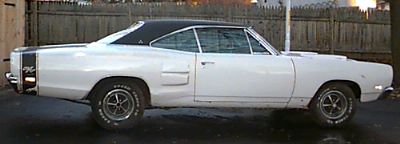 Comments:
The big news for 1969 was the addition of a new optional engine, the 440
Six Pack. The new engine was created by taking the existing 440 and replacing
the single four barrel carb with three two barrel carbs. The new engine
was rated at a stout 390 bhp. The new engine also received a fiberglass
performance hood. Available on other Coronet R/Ts was a Ramcharger fresh-air
induction system (standard on Hemis) with twin hood scoops, plus a wide
choice of rear axle ratios. Styling was similar to 1968 except that the
previous front fender medallion became a large decal that appeared as part
of the rear bumblebee stripe. The 440 four barrel remained standard on
the Coronet R/Ts. The Hemi was just another 8 more. Only 96 two door
hardtops (58 with four speeds) and 10 convertibles (6 with TorqueFlite)
were built with the Hemi. Comments:
The big news for 1969 was the addition of a new optional engine, the 440
Six Pack. The new engine was created by taking the existing 440 and replacing
the single four barrel carb with three two barrel carbs. The new engine
was rated at a stout 390 bhp. The new engine also received a fiberglass
performance hood. Available on other Coronet R/Ts was a Ramcharger fresh-air
induction system (standard on Hemis) with twin hood scoops, plus a wide
choice of rear axle ratios. Styling was similar to 1968 except that the
previous front fender medallion became a large decal that appeared as part
of the rear bumblebee stripe. The 440 four barrel remained standard on
the Coronet R/Ts. The Hemi was just another 8 more. Only 96 two door
hardtops (58 with four speeds) and 10 convertibles (6 with TorqueFlite)
were built with the Hemi.
Production: R/T:
7,238.
Engines: 426 V8 Hemi
425bhp@5000rpm, 490lb-ft@4000rpm. 440 V8 375bhp@4600rpm, 480lb-ft@3200rpm.
440 Six Pack V8 390bhp@4700rpm, 490lb-ft@3200rpm
Performance: R/T
440/390: 0-60 in 6.6 seconds, 1/4 mile in 13.65 seconds @ 105.14 mph.
1970 Dodge Coronet
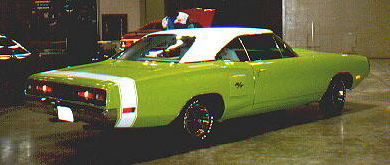 Comments:
The Dodge Coronet R/T received all new front sheet metal for 1970, including
a smooth split grille which tapered towards the center. Dummy rear fender
scoops were now standard and wore R/T badges (repeated on the nose and
between the segmented, tapering taillamps). A bumblebee stripe circled
the rear. Engines were the same as before, with the Hemi an additional
8 more. But low sales made 1970 the last year for the R/T and the convertible.
Only 14 Hemi Coronet R/Ts were built, 13 hardtops and just one convertible. Comments:
The Dodge Coronet R/T received all new front sheet metal for 1970, including
a smooth split grille which tapered towards the center. Dummy rear fender
scoops were now standard and wore R/T badges (repeated on the nose and
between the segmented, tapering taillamps). A bumblebee stripe circled
the rear. Engines were the same as before, with the Hemi an additional
8 more. But low sales made 1970 the last year for the R/T and the convertible.
Only 14 Hemi Coronet R/Ts were built, 13 hardtops and just one convertible.
Production: R/T 2D
Hardtop: 2,319. R/T 2D Convertible: 296.
Engines: 426 V8 Hemi
425bhp@5000rpm, 490lb-ft@4000rpm. 440 V8 375bhp@4600rpm, 480lb-ft@3200rpm.
440 Six Pack V8 390bhp@4700rpm, 490lb-ft@3200rpm
Performance: R/T
440/390: 0-60 in 6.6 seconds, 1/4 mile in 13.65 seconds @ 105.14 mph.
|